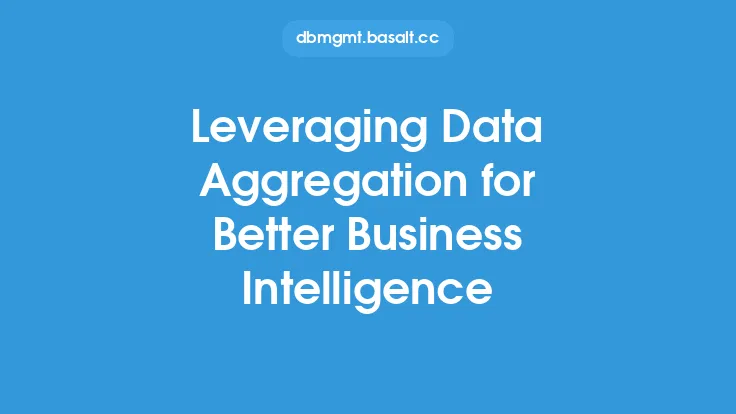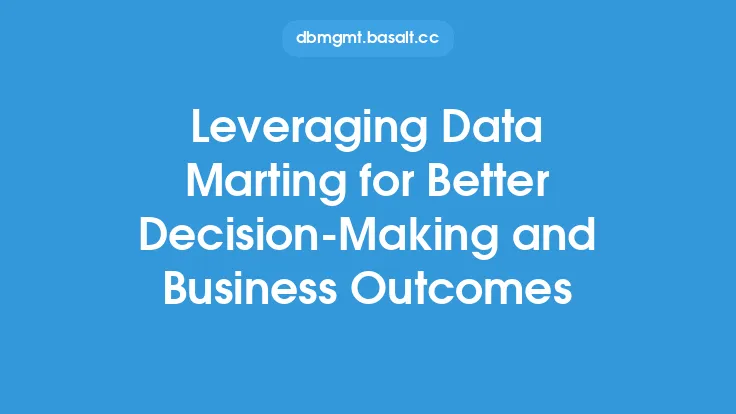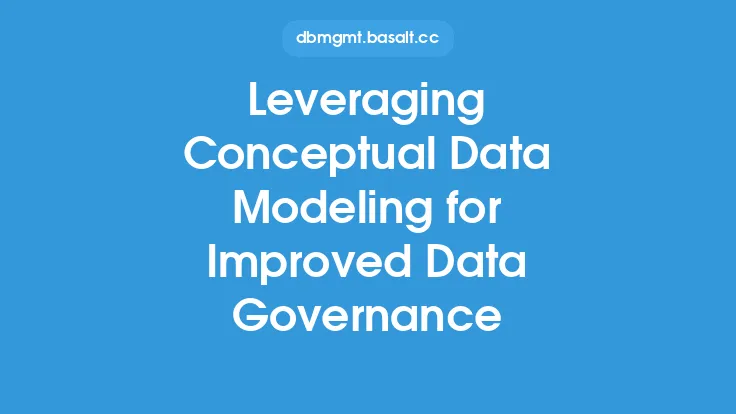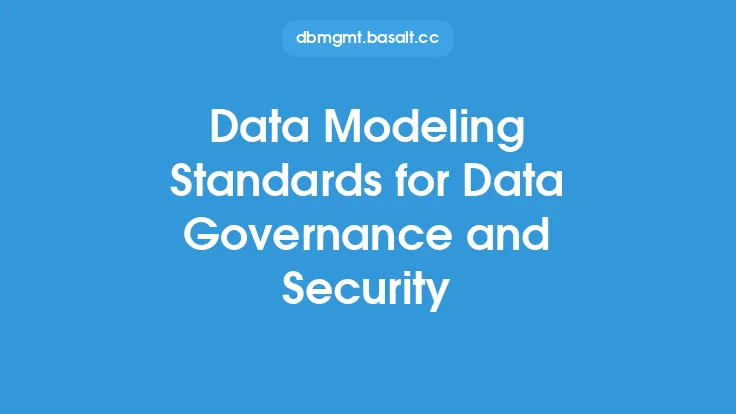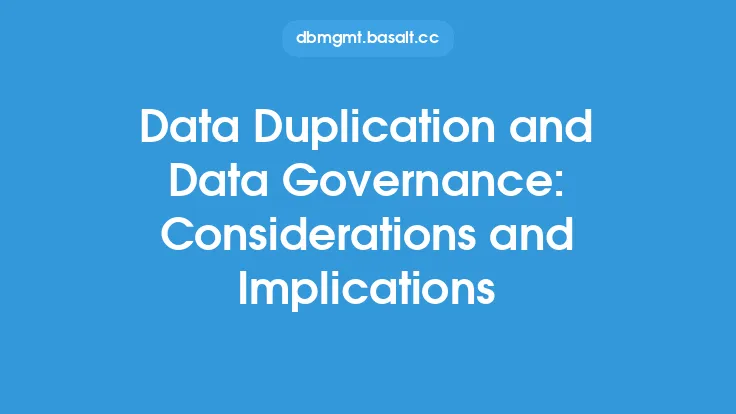In today's data-driven world, organizations are constantly seeking ways to improve their data governance and compliance. One effective approach to achieving this goal is by leveraging data warehousing. A data warehouse is a centralized repository that stores data from various sources in a single location, making it easier to manage, analyze, and report on data. By utilizing a data warehouse, organizations can enhance their data governance and compliance by providing a single source of truth for all data, improving data quality, and reducing the risk of data breaches.
Introduction to Data Warehousing
Data warehousing is a process that involves collecting, storing, and managing data from various sources in a single location. This allows organizations to have a unified view of their data, making it easier to analyze and report on. A data warehouse typically consists of three main components: a data source, a data storage system, and a data access tool. The data source can be any system that generates data, such as a customer relationship management (CRM) system or an enterprise resource planning (ERP) system. The data storage system is the data warehouse itself, which stores the data in a structured and organized manner. The data access tool is used to retrieve and analyze the data from the data warehouse.
Benefits of Data Warehousing for Data Governance and Compliance
Data warehousing offers several benefits for data governance and compliance. Firstly, it provides a single source of truth for all data, which helps to ensure data consistency and accuracy. This is particularly important for organizations that have multiple data sources, as it can be challenging to ensure that data is consistent across all systems. By storing all data in a single location, organizations can ensure that data is accurate and up-to-date. Secondly, data warehousing helps to improve data quality by providing a centralized location for data validation and cleansing. This helps to ensure that data is accurate and consistent, which is critical for making informed business decisions. Finally, data warehousing helps to reduce the risk of data breaches by providing a secure and centralized location for data storage.
Data Warehousing Architecture
A typical data warehousing architecture consists of several layers, including a presentation layer, an application layer, a data access layer, and a data storage layer. The presentation layer is the user interface that allows users to access and analyze the data. The application layer is the layer that interacts with the data warehouse, providing functionality such as data loading and data transformation. The data access layer is the layer that manages access to the data warehouse, providing security and authentication functionality. The data storage layer is the layer that stores the data, providing a scalable and secure location for data storage.
Data Governance and Compliance Framework
A data governance and compliance framework is a set of policies, procedures, and standards that ensure data is managed and used in a way that is consistent with organizational goals and regulatory requirements. A typical framework consists of several components, including data governance policies, data quality standards, data security policies, and compliance procedures. Data governance policies define the rules and guidelines for data management, including data ownership, data access, and data usage. Data quality standards define the criteria for data accuracy, completeness, and consistency. Data security policies define the rules and guidelines for data protection, including access controls, encryption, and authentication. Compliance procedures define the processes for ensuring regulatory compliance, including auditing, reporting, and risk management.
Implementing a Data Warehousing Solution
Implementing a data warehousing solution requires careful planning and execution. The first step is to define the requirements for the data warehouse, including the data sources, data storage, and data access tools. The next step is to design the data warehouse architecture, including the presentation layer, application layer, data access layer, and data storage layer. The third step is to implement the data warehouse, including data loading, data transformation, and data validation. The final step is to test and deploy the data warehouse, including user acceptance testing, performance testing, and deployment to production.
Best Practices for Data Warehousing
There are several best practices for data warehousing that can help ensure a successful implementation. Firstly, it is essential to define clear requirements for the data warehouse, including the data sources, data storage, and data access tools. Secondly, it is crucial to design a scalable and secure data warehouse architecture that can meet the needs of the organization. Thirdly, it is vital to implement a robust data governance and compliance framework that ensures data is managed and used in a way that is consistent with organizational goals and regulatory requirements. Finally, it is essential to continuously monitor and evaluate the data warehouse, including data quality, data security, and system performance.
Common Challenges and Solutions
There are several common challenges that organizations face when implementing a data warehousing solution. One of the most significant challenges is data quality, which can be addressed by implementing a robust data validation and cleansing process. Another challenge is data security, which can be addressed by implementing robust access controls, encryption, and authentication. A third challenge is scalability, which can be addressed by designing a scalable data warehouse architecture that can meet the needs of the organization. Finally, a fourth challenge is user adoption, which can be addressed by providing training and support to users, as well as ensuring that the data warehouse is user-friendly and intuitive.
Future of Data Warehousing
The future of data warehousing is exciting and rapidly evolving. One of the most significant trends is the use of cloud-based data warehousing solutions, which provide a scalable and secure location for data storage. Another trend is the use of big data analytics, which provides the ability to analyze large amounts of data from various sources. A third trend is the use of artificial intelligence and machine learning, which provides the ability to automate data analysis and decision-making. Finally, a fourth trend is the use of data governance and compliance frameworks, which provides the ability to ensure data is managed and used in a way that is consistent with organizational goals and regulatory requirements.
Conclusion
In conclusion, leveraging data warehousing for better data governance and compliance is a critical component of any organization's data management strategy. By providing a single source of truth for all data, improving data quality, and reducing the risk of data breaches, data warehousing can help organizations ensure that their data is accurate, consistent, and secure. By following best practices for data warehousing, including defining clear requirements, designing a scalable and secure architecture, implementing a robust data governance and compliance framework, and continuously monitoring and evaluating the data warehouse, organizations can ensure a successful implementation. As the field of data warehousing continues to evolve, it is essential for organizations to stay up-to-date with the latest trends and technologies, including cloud-based data warehousing solutions, big data analytics, artificial intelligence, and machine learning.
